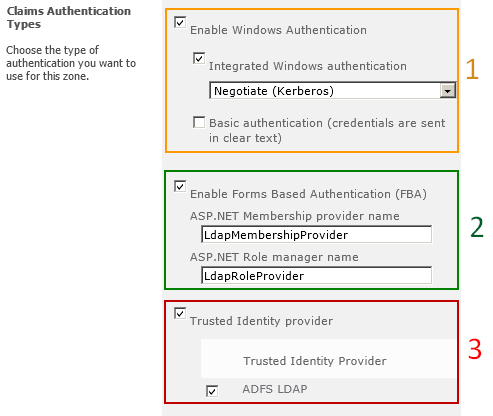FAQ: SharePoint 2010 Claims and K2
This section covers common issues you may encounter with SharePoint 2010 Claims configuration, as well as recommended resolutions.
Legend
1 Identity Provider
2 Identity
3 Role

K2 requires the ClaimType for the IdentityClaim to match the claim mapping configured in SharePoint as the Identifier Claim. The K2 Server Configuration section provides automatic and manual approaches that aid in configuring the appropriate identity claim type mapping for K2.
For more information, see Claim Type Mappings and Mapping SharePoint users to K2 users.
K2 needs to map to the same identity store as the source of the claim to fully implement user and group browsing and user property (e.g., email or manager) lookups. However, user and group browsing and property lookups are not requirements for K2 to function. Strings representing the K2 label and the FQN can be used throughout K2 for rights and work assignment, and properties can be stored and retrieved from other places, such as SharePoint User Profile DB.
K2 provides support for AD, LDAP and SQL source identity stores. A custom user manager can be created to support other identity stores.
Yes. K2 does not retain claim set data and only uses the identity claim at runtime. K2 needs access to the identity store directly to retrieve user details, similar to the SharePoint User Profile store.

Yes. K2 requires #1 (Windows Authentication) and can support any combination of #2 (Forms) and/or #3 (Trusted).
For more information, see Supported Configuration.
No. The K2 service account and any K2 Studio or Visual Studio based designer accounts require access to the claims-based zone via Windows Authentication.
No. K2 does not support the use of multiple zones or alternate access mappings. K2 must utilize the same zone (URL) for both design-time and runtime integration.
Yes. K2 can utilize the data in the user profile database to retrieve attributes for claims-based users via custom code.
No. K2 requires a one-to-one mapping from an identity store to a K2 user manager. Therefore, a single AD FS endpoint that has federated multiple identity stores cannot be configured. K2 supports the development of custom user managers which can manage federated identity stores.